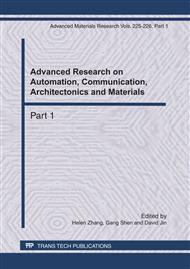p.987
p.992
p.996
p.1000
p.1004
p.1008
p.1012
p.1016
p.1020
Design of Simulation Model of Yarns
Abstract:
Yarns were seen as having a concave-convex structure consisting of a main frame and a twisting according to their morphological structure and property. Simulation model of yarns was built by adopting the virtual reality technique and frame modeling method and texture mapping was used to enhance its trueness. With the surface algorithm NURBS and based on the twisting feature of yarns, the appearance model of yarns can be established by moving and rotating the section of yarns and fitting the control vertex obtained. The experiment shows that both the two methods realize the appearance simulation of yarns and meet the expected effect.
Info:
Periodical:
Pages:
1004-1007
Citation:
Online since:
April 2011
Authors:
Price:
Сopyright:
© 2011 Trans Tech Publications Ltd. All Rights Reserved
Share:
Citation:


